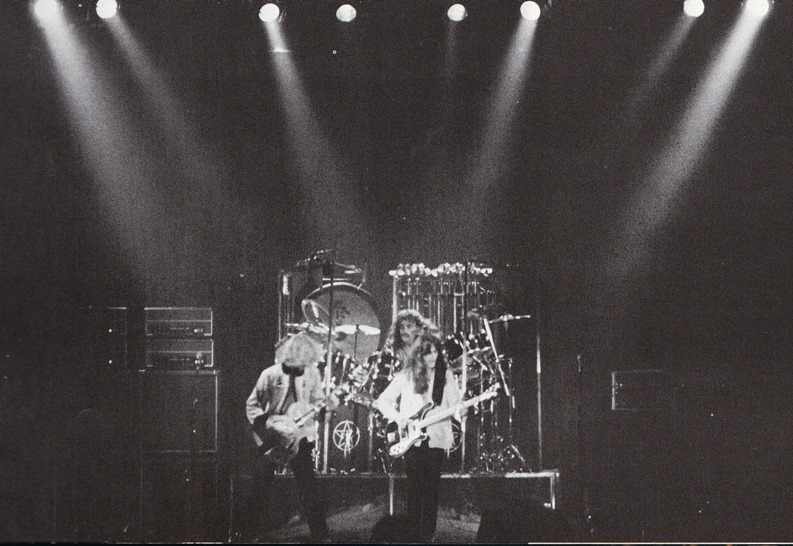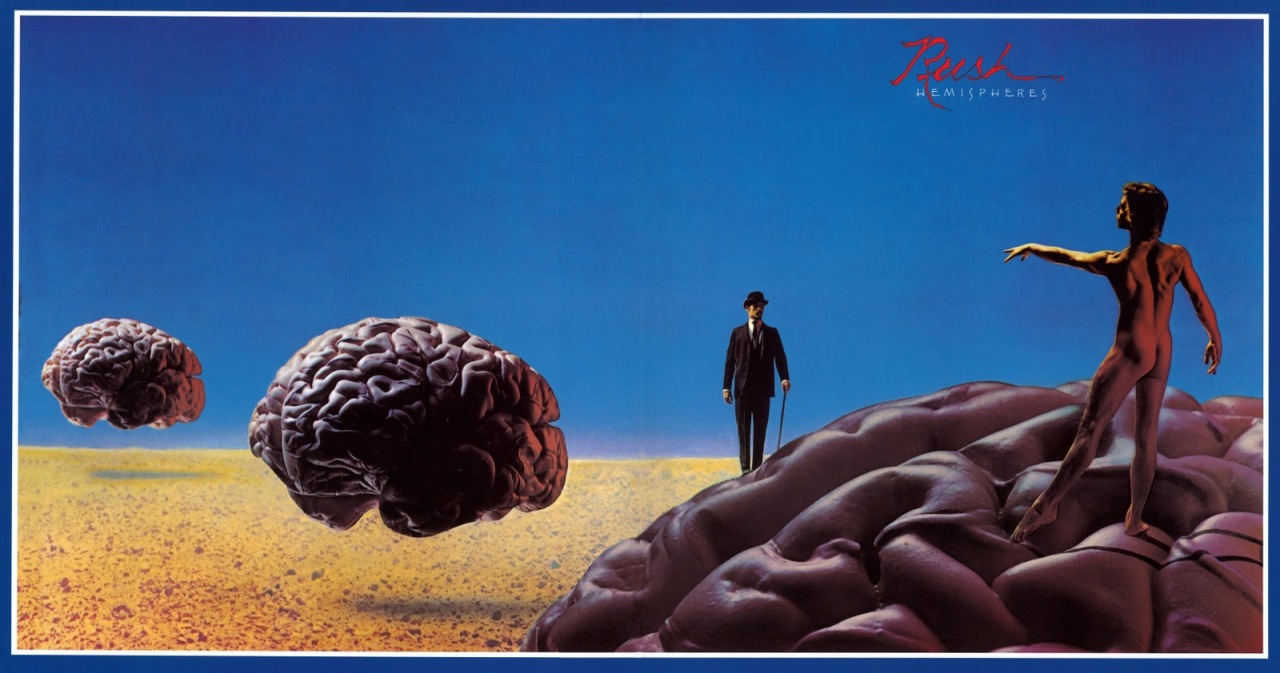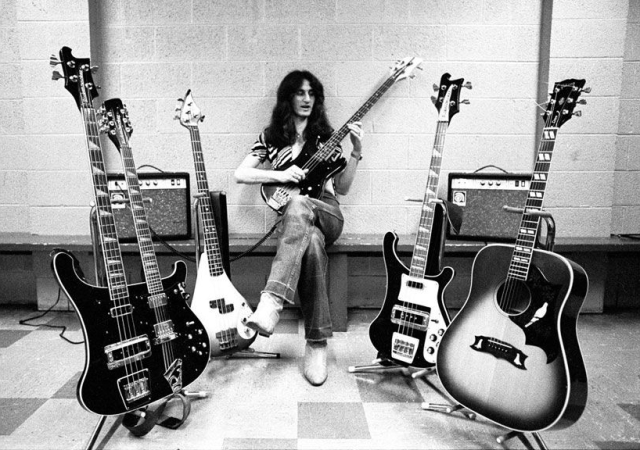On Thursday, May 14, I had to fight through bums, transportation “technical difficulties,” and nosebleed woes to see Rush’s R40 tour stop in St. Louis. Man, was it worth it.
There’s a certain vibe you get during the pre-show hype of a concert. Questions quickly take over. From, “What songs will they play?” to “Do they still have it?” to “$9.00 for a beer? Are you shitting me?” As my nose wrinkled to the skunky smells with hints of body odor, I knew, I just knew Rush was going to succeed in all three categories. Well, maybe the first two. The third is just an unfortunate circumstance. Somehow, in the back of my head, I never dwelt on the fact that Rush would most likely never be back, that, after the show, classic rock stations would bow down, then move on to the next “big” thing, like fucking Sammy Hagar coming back for the millionth time. God, if I had a dollar for every time St. Louis praised Sammy Hagar…That’s besides the point.
 Soon after taking this photo, a pair of drunk fans asked if I was lost (like a child), while a bum inquired for a couple of ‘doobies.’
Soon after taking this photo, a pair of drunk fans asked if I was lost (like a child), while a bum inquired for a couple of ‘doobies.’
Then, Neil Peart opened “The Anarchist.” I felt connected, all questions, all hype, all expectations diminished in those first few seconds. And I realized, that was going to be it. It was a bittersweet moment, really. As expected, Rush came out with the stage presence they trademarked: quirky production pieces, well timed audience interaction, flashy solos and tasteful improvisations. The entire production was showy, as you’d expect from a band as successful as Rush, but never felt like a distraction. The last time Rush came to St. Louis, they had a similar stage setup to R40, in that the design focused on a steam punk, industrial theme. However, the band removed the more showy elements to create a more intimate, retrospective design.
Each part of the stage fit into the show in one way or another. Of course, Geddy’s traditional stage filler was a mix of jokes only he and the other band members understood. It’s well known that Lee prefers venues’ PA systems over traditional amplifiers, favoring overwhelming over isolated sound. To cover up the space, Lee throws in some ‘add-ins,’ such as washing machines or — I think I saw in the Rush in Rio DVD — rotisserie chickens. For the R40 tour, the thunder god displayed a popcorn maker, phonograph, and some chemical tanks or something or another, I couldn’t tell.
Don’t worry, there’s a point to this overblown description of set pieces. As I said, each piece had meaning. The show moved through each era of the band, and in the background, the moving men from Moving Pictures slowly converted the stage props to objects representing their respective time period. Once we reached the halfway point, the stage drop revealed classic production values, complete with old school amplifiers, light setups — which, in turn, were slowly taken away as the band reached their humbler days — and Neil Peart’s retro, 2112 drum kit. A beautiful, cohesive effort from all associated with the Rush brand. Notice, I said brand, not band. The other guys deserve credit too, you know!
SETLIST SPOILER ALERT!
Loo at that. 500 words in and I’m just now getting into the actual performance. Silly me. Rush, as they’ve done for years, split their R40 show into two sets. Starting with Clockwork Angels and going backwards, the band covered years of music with attention to detail and respect for their fans. Both casual listeners and hardcore fans were pleased, hits and epics aplenty. There were two main highlights of the show. The first, at least for me, was the band’s rendition of “Headlong Flight.” The live version, thanks in part to Peart and Lifeson’s solos, blew the studio version out of the water.
On the vocals side, Geddy’s voice shaped up well since his last St. Louis appearance, as evident in his consistent wail during “Flight[‘s]” higher moments. The man sure can sing for his age. He even powered through “Closer to the Heart,” and if you know that song — which you should. If not, why are you even reading this? — you surely know the ability required to sing it. Performance wise, Geddy and Alex moved about the stage constantly, adding in solos here and there to get the crowd going. Meanwhile, Neil Peart worked his magic behind his more elaborate kit, the larger, more expansive monster used in his later years. The fills, the precision, the power, the groove, Neil Peart hit the opening set with a mission.
The other highlight — this is kind of a cheat, but oh well — is the entire second set. It was a Rush fan’s dream, spanning epics and hits from the 70’s. And you know how much RFTOS loves 70’s Rush. Leading in with a fun little video, punctuated by a classic South Park scene, the opening of “Tom Sawyer” shook the venue. You might’ve thought the whole crowd shit their pants. What a moment. The band was electric, Geddy and Lifeson leading the musical charge towards Peart’s cathartic, and might I say classic, drum solo. But that meant nothing to the scale of Peart’s official solo closing “Cygnus X-1.” Prepare for some pretension. Ready? Let’s go!
The axemen cleared and Peart worked his kit at center stage. Now, let’s put this into perspective. This is not Neil’s 1,000 piece behemoth. This is his 70’s-style drum set, enclosed with a few toms, a snare, a couple kicks, some symbols, chimes, and a gong. But the sound, the sound he emoted during his “Cygnus” solo was enormous. A rainbow of lights combined on his set, making his presence almost spiritual, meditative. Yes, at that moment, Neil Peart, you were a drumming god. Okay, take your finger out of your mouth. My fanboy moment is over.
The double neck guitar and bass came out for “Xanadu.” Yes, I’ll repeat that. The double neck guitar and bass came out! Not to mention they played “Xanadu.” The whole damn song! Geddy’s mature voice meshed well with the rendition, and Lifeson’s guitar came across cleanly, which was an issue during the earlier set, well, at least up in the sections the sound engineer says, “who cares” to. I don’t know if the sound guys turned Geddy down, but for some reason the production’s mix was much cleaner after the intermission. “2112” followed with the intensity you’d expect from “2112.” For the encore, Rush came out with a minimal stage setup and pleased older fans with four songs from their earliest records, “Lakeside Park” from Caress of Steel, and “Anthem,” “What You’re Doing,” and the fitting “Working Man” from the band’s debut.
As “Working Man” hit its closing notes, the room exploded with chants, cheers, and thanks. R40 is the way an anniversary tour should be composed. Through its extensive, era-spanning setlist and clever stage production, the band said goodbye in the best way possible. Who knows, maybe they’ll come around one more time. From St. Louis, thank you, Rush, for your dedication to fans and contributions to the progressive rock genre.









